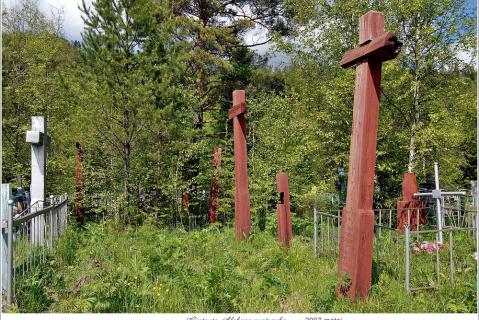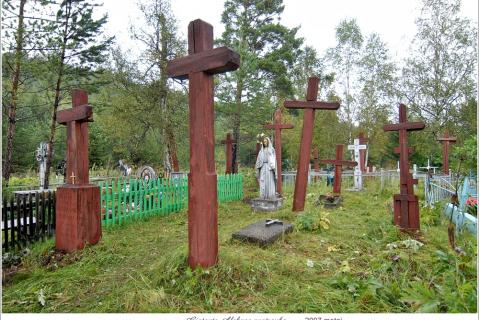Lithuanians were deported to Korbik special settlement in 1948. By the mid-1950s there were about 150 people there. The cemetery was laid out next to the settlement and 30-50 people are buried there: their names are inscribed on tall crosses on their graves. In 1956, a wooden sculpture of the Holy Virgin was placed in the centre of the cemetery. After the special settlement regime was lifted, the Lithuanians returned home. There were also several families of Volga Germans, Ukrainians, Kalmyks and Greeks living at Korbik. The adult males were engaged in logging operations and transporting the timber to the river.
In the 1970s the houses in the village burned down, but the cemetery was not affected. In 1989-1990 a partial exhumation was carried out in order to rebury Lithuanians in their own country. In 2007 the cemetery was studied by the “Destination, Siberia!” youth expedition from Lithuania. By 2010 the original sculpture of the Virgin Mary had become dilapidated and was replaced by a new version.
Research on the Genocide of the Lithuanian People (Lietuvos gyventoju Genocidas; 3 vols. 1999-2009) contains about 130,000 biographical entries (in Lithuanian). Volume 3 covers the period from 1948 onwards and see Deportation of Lithuanians, 1941-1951 for the 29 other burial grounds and commemorative sites on the Map of Memory.
The Memorial online database (2025) includes 55,742 victims in the Krasnoyarsk Krai (Region). See Yeniseisk.
30,000 were sent to camps or special settlements elsewhere. Drawing on other sources, however, the database lists more than 12,000 sent to the the Krasnoyarsk Region, some to its camps (1,017), most to its special settlements (11,000).
| Date | Nature of ceremonies | Organiser or responsible person | Participants | Frequency |
|---|---|---|---|---|
|
nk
|
Commemorative Services
|
nk
|
nk
|
From time to time
|
| State of burials | Area | Boundaries | Other sites in same area |
|---|---|---|---|
|
About 20 crosses and some small fences around graves have survived
|
not determined
|
the graveyard fence has been preserved
|
Sculpture of the Holy Virgin
|
[ Original texts & hyperlinks ]
“Korbik settlement, Berezovsky district. A memorial in a Lithuanian graveyard”, website of Krasnoyarsk Memorial society
R. Racemes, “The Madonna of Korbik: a photo reportage from the Berezovsky district of the Krasnoyarsk Krai [Korbiko Madona]” The Destiny [Lemtis] association, 2010 (in Lithuanian)
“Graveyard of Lithuanian deportees in Korbik settlement”, Virtual Museum of the Gulag [retrieved, 30 May 2022; no longer accessible]



